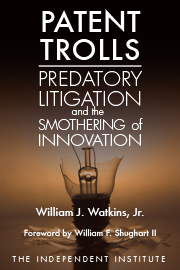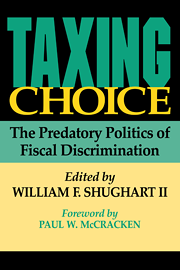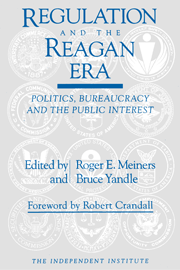The Sherman Act (1890) declares “every contract, combination in the form of trust or otherwise, or conspiracy, in restraint of trade or commerce among the several states, or with foreign nations” (15 U.S.C. §1; emphasis added) to be illegal. The statute’s adoption of “restraint of trade” language has misled some commentators—even brilliant ones like the late Harold Demsetz—into thinking that the Sherman Act merely codified the common law’s hostility to monopoly and other business practices that might interfere with the operations of free and open competitive markets.
However, that interpretation of the purposes and effects of Senator Sherman’s law and later antitrust statutes (like the Clayton and Federal Trade Commission Acts of 1914) overlooks the fundamental fact that disputes between identifiable private parties would no longer be resolved exclusively in common law courts. The new federal statutes authorized the Department of Justice and, subsequently, the Federal Trade Commission (under Section 5 of the FTC Act, which proscribes “unfair methods of competition”) to initiate and litigate charges against private companies they accused of unlawfully restraining trade.
The Sherman Act and its legislative successors established a centralized and asymmetrically powerful framework for antitrust law enforcement. The consequences of that shift should be appreciated more widely and addressed.
A Legal Sea Change
It is one thing for a defendant firm to face accusations of restraining trade from a private party; it is an entirely different matter to deal with the same charge brought by a taxpayer-funded government agency.
The “deep pockets” of public-sector plaintiffs and their weak incentives to control case-related expenses enable the DOJ and the FTC to initiate more antitrust lawsuits and to pursue them longer than benefit-cost considerations would normally justify. Nevertheless, those two federal agencies file significantly fewer cases yearly than private antitrust plaintiffs. The Sherman and Clayton Acts also allow private parties to enforce their provisions, motivated undoubtedly by the statutory prospect of recovering treble damages from a guilty defendant. However, nearly all (70 to 90 percent) of private antitrust lawsuits are settled out of court, indicating that one or both litigants frequently conclude that, owing to the expense and the opportunity cost of executives’ time, pursuing the matter to a final resolution is not worth the effort.
Moreover, section 2 of Senator Sherman’s law declares a private firm’s efforts, either on its own or in combination with other companies, to acquire or maintain a commercial monopoly to be a felony. If found guilty, as of June 2004’s statutory amendments, the guilty defendant(s) can be fined (up to $100,000,000), their executives can be sentenced to prison (up to 10 years), or both. Those penalties differ substantively from the common law’s (civil, not criminal) remedies for restraints of trade, which typically are confined to issuing injunctions to “cease and desist” illegal activities and/or ordering defendants to pay fines meant to compensate plaintiffs for economic injuries sustained.
When a government agency is the plaintiff, any fines collected are deposited into the public treasury rather than paid to the injured party. Before King Henry II recognized that public law enforcement could reliably generate revenue for the Crown, restitution was the only remedy available under common law for victims of all crimes, including theft and murder. Once formal police forces and public prosecutors had been established, private citizens were relieved of responsibility for apprehending, detaining, and prosecuting individuals accused of injuring their persons or property. After such harm became a crime against the state, victims can obtain compensation only by successfully suing the perpetrator in civil court after a criminal judgment has been rendered.
What Was Lost
Common-law courts had dealt with allegations of unlawful restraints of trade for centuries before the US Congress enacted the planet’s first federal antitrust law in 1890. Over time, the courts developed standards, on a case-by-case basis, to determine whether a particular restraint was reasonable and, hence, enforceable or unreasonable and therefore unlawful. Once a dispute is heard and a decision is rendered in favor of one litigant, the ruling can be appealed to a higher court by the losing party and ultimately to a (supreme) court of last resort. Along with the ancient right to trial by jury and the availability of multiple venues wherein disputes can be litigated, appeals processes help reduce lower court errors.
Many law and economics scholars draw parallels between the common law’s institutions and competitive market processes. Over time, some judicial rulings become accepted as precedents that guide court decisions in later cases involving similar facts. Precedents help establish clear and stable expectations about the consequences of individual behavior. Predictability (stare decisis) is a hallmark of the common law, as understood by Bruno Leoni and Frederick Hayek, among others. Classical liberals distinguish sharply between the behavioral rules evolving from the norms and customary practices of ordinary human beings and the top-down rules imposed on them by legislation.
A well-known legal trope is that the common law is “judge-made.” That reading of the operations of the complex institution that emerged in England around the mid-fifth century is too simple. The alternative interpretation, traceable to William Blackstone’s Commentaries on the Laws of England, first published in 1765, is that the job of a common-law judge is not to make the law but to find it in the rules adopted by the community in which the litigants find themselves. Although some legal scholars question judges’ capacities to discover and apply frequently unwritten behavioral norms and customary practices to the matters before them, it has been done. Ghen v. Rich, 8 F. 159 (1881), one of the first cases students encounter in courses on the law of property, involved a dispute over the ownership of a whale (“fugitive property,” as it is called). The crew of a vessel owned by Ghen harpooned a whale off the coast of Massachusetts that sank and days later washed up on a nearby beach. Ellis stumbled upon the whale’s carcass and sold it at auction to a local processing plant owned by Rich. In awarding ownership of the whale to Ghen and ordering Rich to pay damages to him for unlawful conversion, the court relied on the “first-iron” rule adopted by whalers plying the North Atlantic Ocean. (See Robert Ellickson for discussion of whaling industry norms in other corners of the globe.) The North Atlantic’s whalers customarily assigned ownership priority to the ship pursuing a whale that first fixed a harpoon (in fact, a “bomb lance” here) to it. That practice incentivized efforts to locate and capture whales prized at the time for their oil and ambergris. Neither Ellis nor Rich had contributed to that effort.
Statutory law tends to be less flexible and, thus, less likely than common law to promote economic efficiency. Common-law courts do err, but the parties before the bar remain free to contract around mistaken court rulings. Erroneous judicial decisions establish a reversion point from which the parties can begin negotiations to achieve better, more efficient, mutually agreeable outcomes. Such bargaining is generally precluded when decisions are handed down by legislators or the agents of the administrative state. Everyone within the reach of a statute or regulation must comply or face sanctions for not doing so. While some exceptions may be statutorily or administratively granted, paying less than a mandated minimum wage or charging more than a controlled maximum rent is prohibited.
Common law processes are imperfect. Error rates are high, uncertainty concerning litigation outcomes often obliges both parties to spend heavily on lawyers and expert witnesses, and juries may be swayed more by the comparative courtroom demeanors and performances of the parties’ legal advocates than by the facts presented. “The Play’s the Thing” in adversarial common-law trials, according to Gordon Tullock. While all of that may be so, public choice theory helps explain why replacing traditional common law procedures with public enforcement of statutory proscriptions against monopoly should not be celebrated.
Antitrust Law Enforcement in Public-Choice Perspective
Blind faith in the rule of experts motivated civil service reforms under the first progressive US presidents, Theodore Roosevelt and Woodrow Wilson. Both naively thought that the incompetence and corruption obvious under the prevailing “spoils system” would be minimized by staffing the executive branch’s administrative departments with qualified professionals, who thenceforth would reliably implement Congress’s legislative instructions without fear or favor.
Public choice (“politics without romance,” in James Buchanan’s words) emphasizes behavioral symmetry and adds a dose of reality to comprehending bureaucratic behavior. Economists and other social scientists cannot logically adopt two different models to explain human action: one for ordinary markets (self-interest, broadly construed) and another for non-market settings like government (“public interest”). If one seeks to understand why outcomes in the private sector differ from those in the public sector, the analytical focus must be on institutions (incentives and constraints) rather than the motivations of the relevant actors in the two settings.
Law enforcement agencies are no exception. For more than a century, scholars studying the origins and consequences of antitrust legislation—both at home and abroad—have been harshly critical of its application in many specific cases. If one assumes that the Justice Department, the FTC, states’ attorneys general, whose antitrust authority arises under “little” Sherman and FTC acts, and the European Commission all seek to serve the public’s interest by safeguarding competitive market conditions, then those mistakes can be explained only by bureaucratic error or ignorance. Such explanations amount to unscientific handwringing.
Public choice reasoning began to be applied to antitrust law enforcement only in the 1970s and, more seriously, in the 1980s and beyond. (Shughart and McChesney 2010 and Shughart 2022 offer recent literature summaries.) One lesson of that literature is that the parochial incentives of bureaucrats and the political pressures exerted on the agencies by parties with important stakes in antitrust law enforcement outcomes shape decisions at every step in the process, from launching a formal investigation into alleged anticompetitive behavior to filing and litigating a complaint against a defendant company, and on to devising an effective remedy for business acts or practices determined to be unlawful. The lawyers and economists employed by the antitrust bureaus are too distant from the marketplace to comprehend the current state of competition or predict its future evolution with or without intervention. Demanding the production of truckloads of company documents and deposing their executives do not overcome bureaucrats’ lack of Hayekian knowledge of the “peculiar circumstances of time and place” underpinning actual business decisions.
The recent reinvigoration of antitrust law enforcement, especially in high-technology industries, has not improved on the historical record. Past mistakes, such as drawing the boundaries of the markets relevant for assessing competitive conditions too narrowly, continue apace. (See here, here, here, and here.) After the American Bar Association published a report harshly critical of the Federal Trade Commission in 1969, Judge Richard Posner recommended repealing the FTC Act and abolishing the Commission altogether. He later changed his mind. More recently, a former FTC General Counsel proposed folding the Commission’s antitrust authority into the Department of Justice.
Because the DOJ’s antitrust law enforcement record is as checkered as that of the FTC (see the literature linked to in the previous paragraph), such reforms are unlikely to lessen the antitrust bureaus’ obvious problems. Eliminating the public sector’s authority to enforce purposely vague competition statutes and relying fully on the common law’s centuries of experience in adjudicating claims that trade has been restrained would be more consistent with the norms of liberty and freedom of contract.
Justice Thurgood Marshall characterized the Sherman Act as “the Magna Carta of free enterprise” in United States v. Topco Associates, 405 U.S. 596 (1972). However, it has proven to be no such thing. Like other forms of public regulation, the statute has not promoted competition and protected consumers. Rather, it has been a tool wielded by bureaucrats and self-serving competitors seeking to win in the courtroom what they’ve failed to win in the marketplace.











